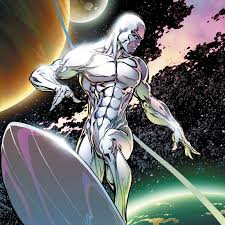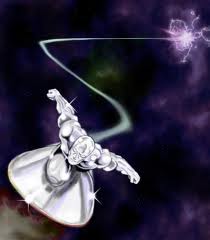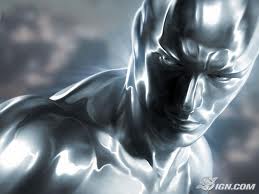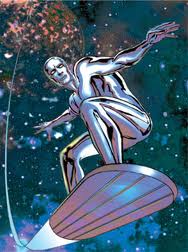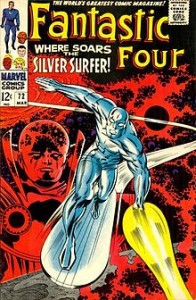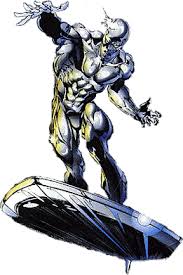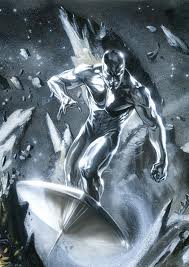Silver Surfer
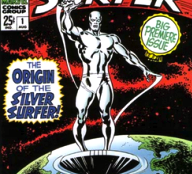
Silver Surfer: TAS – The End of Eternity
The Silver Surfer #1 (Aug. 1968). Cover art by John Buscema and Joe Sinnott.
The Silver Surfer is a fictional character, a superhero appearing in comic booksand other publications by Marvel Comics. Originally a young astronomer named Norrin Radd on the planet Zenn-La, he saved his homeworld from the planet devourer, Galactus, by serving as his herald. Imbued in return with a tiny portion of Galactus’s Power Cosmic, Radd acquired vast power, a new body and a surfboard-like craft on which he could travel faster than light. Now known as the Silver Surfer, Radd roamed the cosmos searching for planets for Galactus to consume. When his travels took him to Earth, he met the Fantastic Four, a team of powerful superheroes who helped him rediscover his humanity and nobility of spirit. Betraying Galactus, the Surfer saved Earth but was exiled there as punishment. In 2011, IGN ranked Silver Surfer 41st in its “Top 100 Comic Heroes” list.
Publication history
Created by artist Jack Kirby, the character first appears in The Fantastic Four #48 (March 1966), the first of a three-issue arc that fans call “The Galactus Trilogy.”
Early appearances
The Silver Surfer debuted as an unplanned addition to the superhero-team comic Fantastic Four#48 (March 1966). The comic’s writer-editor, Stan Lee, and its penciller and co-plotter, Jack Kirby, had by the mid-1960’s developed a collaborative technique known as the “Marvel Method“: the two would discuss story ideas, Kirby would work from a brief synopsis to draw the individual scenes and plot details, and Lee would finally add the dialog and captions. When Kirby turned in his pencil art for the story, he included a new character he and Lee had not discussed. As Lee recalled in 1995, “There, in the middle of the story we had so carefully worked out, was a nut on some sort of flying surfboard.” He later expanded on this, recalling, “I thought, ‘Jack, this time you’ve gone too far.'” Kirby explained that the story’s agreed-upon antagonist, a god-like cosmic predator of planets named Galactus, should have some sort of herald, and that he created the surfboard “because I’m tired of drawing spaceships!” Taken by the noble features of the new character, who turned on his master to help defend Earth, Lee overcame his initial skepticism and began adding characterization. The Silver Surfer soon became a key part of the unfolding story.
Following the Surfer’s debut, Lee and Kirby brought him back as a recurring guest in Fantastic Four #55-61, 72, and 74-77 (ranging Oct. 1966 – Aug. 1968). The character made his solo debut in the backup story of Fantastic Four Annual #5 (Nov. 1967).
The following year, Lee launched the solo title The Silver Surfer. John Buscema was penciller for the first 17 issues of the series, with Kirby returning for the 18th and final issue. The first seven issues, which included anthological “Tales of the Watcher” backup stories, were 72-page (with advertising), 25-cent “giants”, as opposed to the typical 36-page, 12-cent comics of the time. Thematically, the stories dealt with the Surfer’s exile on Earth and the inhumanity of man as observed by this noble yet fallen hero. Though short-lived, the series became known as one of Lee’s most thoughtful and introspective works.
Following his series’ cancellation, the Surfer made sporadic appearances as a guest star or antagonist in such comic books as Thor, The Defenders, and Fantastic Four. Lee remained partial to the Surfer, and with Kirby collaborated on a seminal 1978 graphic novel starring the character, the only original story featured in the Marvel Fireside Books series.
Subsequent series
Initially written by Steve Englehart, the series was to be set on Earth and one issue was completed under this premise before Marvel agreed to let Englehart remove the long-standing restriction regarding Silver Surfer being imprisoned on Earth. This first issue was shelved and a brand new first issue was written, to set up this plot twist; the original first issue would ultimately be reprinted in Marvel Fanfare #51.After a 1982 one-shot by writer-artist John Byrne (with scripting by Stan Lee), the Surfer appeared in his second solo, ongoing title in 1987.
Englehart introduced many villains for Silver Surfer, as well as featured space politics involving Surfer’s homeworld Zenn-La, which was caught in the middle of a renewed Kree-Skrull War. However, issues regarding Englehart wanting to use his Avengers character Mantis as Silver Surfer’s companion, as well as editorial refusing to let him use Thanos or other concepts conceived by Jim Starlin, led Englehart to leave the book with issue #31. Jim Starlin took over as writer with issue #34 after several fill-in issues, and incorporated Thanos, Adam Warlock, and Drax the Destroyer into the series.
Under Starlin and later Ron Marz, the series would receive acclaim and sales boost due to Silver Surfer’s involvement with Starlin’s Infinity Trilogy, with George Pérez and J. M. DeMatteis also having brief writing stints on the series as well. Additional artists included Tom Grindberg, Ron Garney, and Jon J. Muth, as well as periodic guest spots by John Buscema. The title experienced great initial success which allowed Marvel to push the character into other media, including a 1990 video game, 1992 trading card set, and 1998 animated series, as well as spinning off a variety of other comics series including Cosmic Powers,Cosmic Powers Unlimited, Captain Marvel vol. 2, and Star Masters. It ran 146 issues, through 1998. The next year it was followed by the two-issue miniseries, Silver Surfer: Loftier Than Mortals.
A two-issue Silver Surfer miniseries (later collected as Silver Surfer: Parable), scripted by Lee and drawn by Moebius, was published through Marvel’s Epic Comics imprint in 1988 and 1989. Because of inconsistencies with other stories, it has been argued that these stories actually feature an alternate Silver Surfer from a parallel Earth. This miniseries won the Eisner Awardfor best finite/limited series in 1989.
2000’s
A new ongoing Silver Surfer series began in 2003, focusing on the character’s alien nature and messianic allegory. It lasted 14 issues. The Surfer later appeared in an issue of Cable & Deadpool and has been reunited three times with the superhero group the Defenders. In 2006-2007, he starred in the four-issue miniseries Annihilation: Silver Surfer and co-starred in the miniseries Heralds of Galactus, both part of the Annihilation fictional crossover.
In 2007, the Silver Surfer starred in a four-issue miniseries Silver Surfer: Requiem by writer J. Michael Straczynski and artist Esad Ribic. The first issue was released May 30, 2007 to coincide with the character’s first movie appearance. Published under the Marvel Knights imprint, Silver Surfer: Requiem portrays the character upon learning that he is dying as the silver shell he is encased in is deteriorating.
This was followed by the miniseries Silver Surfer: In Thy Name, by writer Simon Spurrier and artist Ten Eng Huat.
After an appearance in the “Planet Hulk” storyline in 2006, the Surfer was featured in its spin-off series starring the Hulk’s son Skaar in 2008, both written by Greg Pak.
2010’s
The Silver Surfer received a sixth volume, an eponymous 5-issue mini-series written by Pak, debuting in February 2011. He was also a core cast member in The Thanos Imperative (2010), Annihilators (2011), and Fear Itself: The Deep (2011). Beginning in 2011, the Silver Surfer began appearing regularly in The Mighty Thor and a new volume of Defenders, both written by Matt Fraction.
Fictional character biography
The Silver Surfer as depicted by the character’s visual creators, Jack Kirby and Joe Sinnott, on the cover of Fantastic Four#72 (March 1968). This example also highlights the pseudo-fractal light illusion known as Kirby krackle, which Kirby and Sinnott often employed with the Surfer and other cosmic, spacefaring Marvel characters.
Norrin Radd is from the utopian planet Zenn-La, in the Deneb star system of the Milky Way galaxy. He is the son of Jartan and Elmar Radd, and he has a half-brother, Fennan Radd. Zenn-La’s ancient and significantly advanced civilization has lost the will to strive or explore, leaving the young scholar Norrin Radd restless and yearning for adventure. Facing the destruction of his world by planet-consuming Galactus, Radd bargains with the cosmic being. In return for the safety of Zenn-La and his lover, Shalla-Bal, Radd pledges to seek out planets for the world devourer to consume as his herald. Galactus imbues him with a portion of the Power Cosmic, transforming him into the Silver Surfer. Radd had intended to lead Galactus to uninhabited planets, but Galactus tampers with his soul to prevent this.
Radd serves Galactus for an unspecified amount of time. Eventually, the Surfer summons his master to Earth. Here the Surfer meets the Fantastic Four and Alicia Masters. Touched by their nobility, he rebels against Galactus, who is eventually driven off. Before he leaves, he confines the Surfer to Earth with an invisible barrier that affects only him.
During his exile, the Surfer fights numerous villains, including Doctor Doom, who wants his Power Cosmic, and Mephisto, who wants his soul. The Surfer’s only ally during these trials is a physicist by the name of Al B. Harper, who eventually sacrifices himself to save the world from the Stranger.
Banding together with the Hulk and Namor the Sub-Mariner during these wanderings, the Surfer forms the “Titans Three,” a group dedicated to battling evil on Earth. Soon, Doctor Strange joins the group and it becomes “The Defenders.” Surfer stays with them for a while, but his overwhelming desire to be free of Earth and his frequent collisions with Galactus’ energy-draining barrier eventually drives him to leave the group.
The Surfer finally pierces Galactus’ barrier with the aid of Reed Richards and temporarily escapes Earth. He discovers, though, that his homeworld has been ravaged by Galactus and Shalla-Bal has been abducted by Mephisto and taken to Earth. Even though it means trapping himself once more, the Surfer returns to Earth to battle and defeat Mephisto. Before being vanquished, Mephisto sends Shalla-Bal back to Zenn-La, but the Surfer manages to endow her with a portion of his Power Cosmic, which she uses to revitalize the plant life of their ravaged homeworld.
After the Surfer aids the Fantastic Four against Galactus’ latest herald, Terrax, Surfer finally manages to pierce Galactus’ barrier by acting on the Thing’s suggestion of trying to pass through on a spaceship instead of via his own power on his surfboard. He also manages to make peace with Galactus by rescuing his current herald, Nova (Frankie Raye), from the Skrulls and encounters the Champion, after which Galactus finally declares the Surfer’s long exile ended. He immediately revisits his homeworld, but Shalla-Bal, in his absence, had become empress of the rejuvenated Zenn-La and hence unable to renew their romance.
Embroiled in fresh hostilities between the interstellar Kree and Skrull empires, the Surfer also intervenes in a series of plots by theElders of the Universe, who plan to become supremely powerful by destroying Galactus and the universe with him. The Surfer thwarts this plot with the aid of his new love interest, Mantis, the Earth-born cosmic heroine also known as the “Celestial Madonna.” She seems to die in the process, and although she eventually returns, she never fully renews their romances. After this loss, a grief-stricken Surfer turns to Nova and romantic feelings begin to develop between them. The Surfer’s influence gradually leads Nova to question the morality of her role as herald to Galactus. Eventually replaced by the far more ruthless Morg, Nova dies in a conflict between the new herald and the Surfer and the other ex-heralds.
The Surfer repeatedly battles space-born menaces, the chief of whom is Thanos, who attempts to kill half the life in the universe using the omnipotent Infinity Gauntlet. Through Thanos, the Surfer learns how Galactus had altered his soul. He convinces Galactus to restore it, but once Galactus has done so, the Surfer is overcome with grief until he is able to forgive himself. The Surfer finds interstellar allies in Adam Warlock‘s Infinity Watch and the “Star Masters” team, and he begins attending occasional Defenders reunions.
The Surfer returns home to Zenn-La to find that the planet has vanished, and learns it was actually destroyed in the 1940’s (Earth time) by the entity known as the Other. Zenn-La and its people which the Surfer repeatedly encountered since leaving Galactus’ service were actually reproductions, created by Galactus so that the Surfer would have a home to return to. Losing his capacity for emotion again, the Surfer returns to Earth. He later regains his personality during a time-travel adventure and sharing a romance with Alicia Masters. The two ultimately part as friends after many adventures together.
Later, the Surfer works with the alien Annunaki race to gather and protect some of Earth’s most extraordinarily gifted children. In the end, one of these children, Ellie Waters, saves Earth from the godlike Marduk entity, preventing the apocalypse and reordering reality as if the Marduk crisis had never happened (though Ellie alone apparently retains her memories of these events). The Surfer resumes his interstellar wanderings, but promises to be ready to aid his adopted homeworld should Earth ever need him.
During his travels, the Surfer is captured by a portal of the Planet Sakaar Empire. Left weakened and vulnerable by his trip through the portal, the Surfer is subdued and implanted with an obedience disk to ensure he remains loyal to them. Fighting as a gladiator (and believed to be the fabled ‘Sakaarson’ due to his appearance), the Surfer is finally forced to face the Hulk along with his Warbound. Through teamwork and distraction, the Hulk is eventually able to destroy the Surfer’s obedience disk. The Hulk and several other slaves and gladiators are freed when the Surfer uses the Power Cosmic to remove their own obedience disks and give them a way out of the arena, although the Hulk declines the Surfer’s offer to take him back to Earth.
During the Annihilation war, the Silver Surfer again becomes Galactus’ herald to help save the universe from the despot Annihilus. Annihilus captures them and gives them to Thanos for experimentation. Drax the Destroyer frees the Surfer, who in turn frees Galactus. An enraged Galactus destroys more than half the Annihilation Wave, and Annihilus is defeated. Later, the Surfer is joined as herald by Stardust, a former herald the Surfer had replaced.
The Surfer leads the world devourer to the populated planet Orbucen, which brings him into conflict with Richard Rider. He delays the planetary destruction to give the inhabitants more time to evacuate.
The Silver Surfer returns to Sakaar in a plan to feed Galactus with the unique “Old Power” which he claims would sate his master’s hunger for thousands of years, sparing many other inhabited worlds. He is opposed by the Hulk’s son Skaar, and is enslaved by an obedience disc. The conflict is ended when Skaar’s mother Caiera sacrifices her soul and Old Power as sustenance for Galactus. Unfortunately, Galactus now seems addicted to the Old Power and has begun searching for other planets containing it to sate himself.
After an encounter with the High Evolutionary, the Silver Surfer and Galactus battled Thor and the Asgardians. The battle ended when the Silver Surfer chose to leave his post as herald and guard an Asgardian artifact. Galactus “tethers” him to Asgard’s location in Oklahoma, resulting in his powers waning the further he travels from Asgard, and grants him the ability to return to human form.
During the war with the Serpent, Silver Surfer aids Doctor Strange, Namor, Loa, and Lyra in the liberation of New Atlantis from Attuma (in the form of Nerkodd: Breaker of Oceans). He subsequently aided Loki in ‘reactivating’ Mjolnir so that it could restore the deceased Thor’s memory in time to allow him to return to life.
Powers and abilities
The Silver Surfer wields the Power Cosmic, granting him superhuman strength, endurance, senses and the ability to absorb and manipulate the universe’s ambient energy. The Surfer can navigate through interstellar space and hyperspace, which he can enter to exceed the speed of light when flying on his board. He has proven capable of time travel on several occasions, even able to make others time-travel with him.
The Surfer sustains himself by converting matter into energy; does not require food, water, air, or sleep (although he occasionally enters a sleep-like meditation in order to dream); and can survive within nearly any known natural environment, including deep space, hyperspace, and even within black holes and stars. The Surfer can project energy in various forms for offensive and defensive use, including bolts of cosmic force powerful enough to destroy entire planets, and create black holes. He can utilize the Power Cosmic to augment his superhuman strength to indeterminate levels. The Surfer can heal living organisms, though he cannot raise the dead, and he has proven capable of revitalizing and evolving organic life on a planet-wide scale. He can cast illusions, create interdimensional portals to other locations including microverses, phase through solid matter, and exercise some level of control over the Astral Plane.
His senses enable him to detect objects and concentrations of energy light years away and to perceive matter and energy in subatomic detail, including life energies of living beings.[71] The Surfer can even see through time, and with concentration he can achieve limited perception of past and future events in his general vicinity. He has demonstrated telepathic ability, including mind-reading on occasion, and has proven to be able to influence human emotion and sensation.
The Surfer’s board is composed of a nearly impervious, cosmically powered silvery material that is similar to his own skin. The board is mentally linked to the Surfer and moves in response to his mental commands even when he is not in physical contact with it. The board is nearly indestructible, but on those rare occasions when it has been damaged or destroyed, the Surfer has proven able to repair it, or even recreate it, with little effort. The Surfer can attack opponents remotely by directing the board against them, and the board is capable of absorbing and imprisoning other beings, at least temporarily.
When Galactus exiled the Surfer to Earth, his means of imprisonment was linked to the board. When the Surfer and the Fantastic Four realized this, the Surfer put it to the test by leaving the board planet-side and entering space in the Four’s spacecraft. Once he was free of Earth, the Surfer remotely converted the board to energy, recalled it to him, and reformed it in space.
Norrin Radd also possesses some knowledge of the advanced alien technology of the planet Zenn-La.


